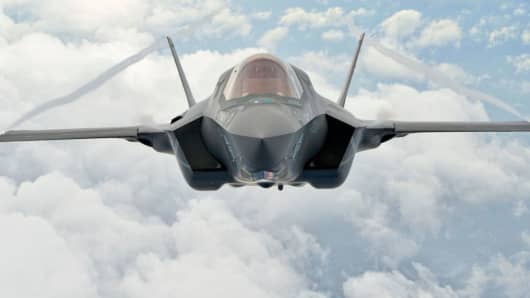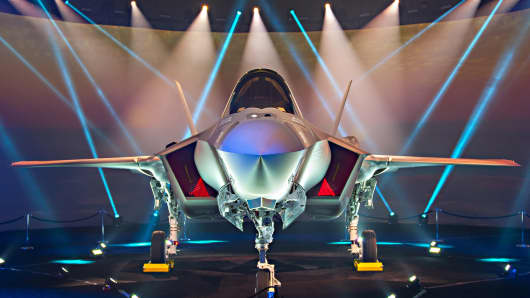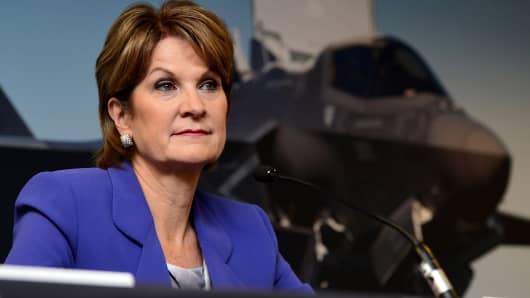- White House trade advisor Peter Navarro on Tuesday tore into Chinese trade practices aimed at stealing American companies' intellectual property.
- The Chinese J-31 fighter jet is believed to be a knockoff of Lockheed Martin's F-35.
- The F-35, a fifth-generation stealth fighter, is the Pentagon's most expensive weapons system.

As the world's largest economies threaten tit-for-tat tariffs, White House trade advisor Peter Navarro tore into Chinese trade practices aimed at stealing American companies' intellectual property.
U.S. officials have long complained that intellectual property theft has cost the economy billions of dollars in revenue and thousands of jobs.
"China has targeted America's industries of the future," Navarro said Tuesday citing aerospace, robotics and artificial intelligence as technologies threatened by Chinese cybertheft.
"If China successfully captures these emerging industries of the future, America will have no economic future and its national security will be severely compromised," he said adding that "economic security is national security."
For the Pentagon, there is no better example of Navarro's comments than the most expensive U.S. weapons system: the F-35 Joint Strike Fighter.
On Oct. 26, 2001, the Pentagon awarded Lockheed Martin a contract worth more than $200 billion to build the next-generation stealth strike fighter.
The Pentagon's request was colossal: Develop a fifth-generation aircraft capable of replacing four existing kinds of U.S. military aircraft that also satisfies the needs of international partners.
What's more, design three variants of the fighter in order to accommodate the unique missions of each sister-service branch: the F-35A for the Air Force, F-35B for the Marine Corps, and F-35C for the Navy.

Lockheed Martin's F-35A Lightning II fighter jet for the Israeli Air Force.
As America's next fighter jet came to life, some of its sensitive design and electronics data were believed to be compromised in 2009.
Chinese hackers were believed to be behind the cyber-intrusion since its stealth Shenyang J-31 jet bears a remarkably striking resemblance to the F-35.
And before the J-31 mimicked the F-35, there was the curious case of the J-20 and the F-22.
In another instance of alleged industrial espionage, the prototypes of China's Chengdu J-20 stealth fighter jet looked suspiciously similar to the sleek design of Lockheed's F-22 Raptor.
While the U.S.-made Lockheed Martin jets are believed to have better computer software, more sophisticated sensors and sensitive stealth coating, the theft of intellectual property gives adversaries the opportunity to avoid the expense and delays involved with research and development.

Marillyn Hewson, the Chairman, President and Chief Executive Officer of Lockheed Martin.
In March, President Donald Trump signed an executive memorandum that penalized China for trade practices such as industrial espionage.
The measures impose retaliatory tariffs on about $60 billion in Chinese imports.
On hand for the signing was Lockheed Martin CEO Marillyn Hewson, who oversees the F-35 Joint Strike Fighter.
"We buy billions and billions of dollars worth of that beautiful F-35," Trump said before asking Hewson to say a few words.
Hewson said intellectual property is the "lifeblood" of the defense industry and welcomed the action taken by the Trump administration.
"This is a very important moment for our country, in that we are addressing a critical area for the aerospace and defense industry and that is protecting our intellectual property," she said.
And before the J-31 mimicked the F-35, there was the curious case of the J-20 and the F-22.
In another instance of alleged industrial espionage, the prototypes of China's Chengdu J-20 stealth fighter jet looked suspiciously similar to the sleek design of Lockheed's F-22 Raptor.
While the U.S.-made Lockheed Martin jets are believed to have better computer software, more sophisticated sensors and sensitive stealth coating, the theft of intellectual property gives adversaries the opportunity to avoid the expense and delays involved with research and development.

Marillyn Hewson, the Chairman, President and Chief Executive Officer of Lockheed Martin.
In March, President Donald Trump signed an executive memorandum that penalized China for trade practices such as industrial espionage.
The measures impose retaliatory tariffs on about $60 billion in Chinese imports.
On hand for the signing was Lockheed Martin CEO Marillyn Hewson, who oversees the F-35 Joint Strike Fighter.
"We buy billions and billions of dollars worth of that beautiful F-35," Trump said before asking Hewson to say a few words.
Hewson said intellectual property is the "lifeblood" of the defense industry and welcomed the action taken by the Trump administration.
"This is a very important moment for our country, in that we are addressing a critical area for the aerospace and defense industry and that is protecting our intellectual property," she said.